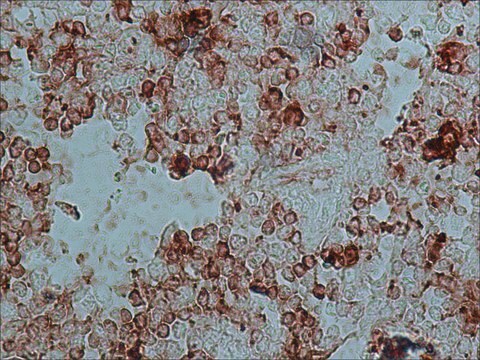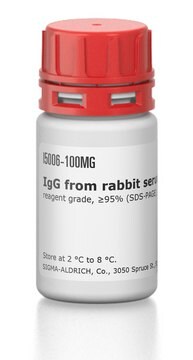R4880
Anti-Rabbit IgG (whole molecule) antibody produced in goat
affinity isolated antibody, lyophilized powder
Sign Into View Organizational & Contract Pricing
All Photos(1)
About This Item
clone:
polyclonal
application:
IEP
technique(s):
immunoelectrophoresis: suitable
citations:
16
Recommended Products
biological source
goat
Quality Level
conjugate
unconjugated
antibody form
affinity isolated antibody
antibody product type
secondary antibodies
clone
polyclonal
form
lyophilized powder
technique(s)
immunoelectrophoresis: suitable
storage temp.
2-8°C
target post-translational modification
unmodified
Looking for similar products? Visit Product Comparison Guide
General description
Binds all rabbit Igs.
Application
Anti-Rabbit IgG (whole molecule) antibody produced in goat is suitable as secondary antibody in immunoblotting.
Applications in which this antibody has been used successfully, and the associated peer-reviewed papers, are given below.
Western Blotting (1 paper)
Western Blotting (1 paper)
Biochem/physiol Actions
IgG antibody subtype is the most abundant of serum immunoglobulins of the immune system. It is secreted by B cells and is found in blood and extracellular fluids and provides protection from infections caused by bacteria, fungi and viruses. Maternal IgG is transferred to fetus through the placenta that is vital for immune defense of the neonate against infections.
Other Notes
Antibody adsorbed with human serum proteins.
Physical form
Lyophilized from 0.01 M sodium phosphate, 0.015 M sodium chloride, pH 7.2
Reconstitution
Reconstitute with 0.135 M sodium chloride.
Disclaimer
Unless otherwise stated in our catalog or other company documentation accompanying the product(s), our products are intended for research use only and are not to be used for any other purpose, which includes but is not limited to, unauthorized commercial uses, in vitro diagnostic uses, ex vivo or in vivo therapeutic uses or any type of consumption or application to humans or animals.
Not finding the right product?
Try our Product Selector Tool.
Storage Class Code
11 - Combustible Solids
WGK
WGK 3
Flash Point(F)
Not applicable
Flash Point(C)
Not applicable
Personal Protective Equipment
dust mask type N95 (US), Eyeshields, Gloves
Choose from one of the most recent versions:
Already Own This Product?
Find documentation for the products that you have recently purchased in the Document Library.
Customers Also Viewed
On-site quantification of human urinary albumin by a fluorescence immunoassay.
Sunga Choi et al.
Clinical chemistry, 50(6), 1052-1055 (2004-05-27)
M Rudling et al.
The American journal of pathology, 153(6), 1923-1935 (1998-12-10)
The high-affinity degradation of low-density lipoprotein (LDL) is enhanced 3- to 100-fold in leukemic blood cells from patients with acute myelogenous leukemia (AML), suggesting an increased cellular LDL receptor expression. There are, however, inconsistencies regarding the published properties of LDL
Jinsu Kim et al.
ACS applied materials & interfaces, 7(4), 2891-2898 (2015-01-13)
We demonstrated a lateral flow immunoassay (LFA) for detection of viruses using fluorescently labeled M13 bacteriophage as reporters and single-reporter counting as the readout. AviTag-biotinylated M13 phage were functionalized with antibodies using avidin-biotin conjugation and fluorescently labeled with AlexaFluor 555.
Shanshan Huang et al.
Pathology, research and practice, 215(4), 794-800 (2019-01-27)
Numbers of studies have indicated that miRNA-708 plays an important role in many types of cancer. However, the role of miRNA-708 in pancreatic ductal adenocarcinoma (PDAC) has yet to be fully elucidated. The present study aimed to investigate the role
Peter Engelhardt et al.
Methods in molecular biology (Clifton, N.J.), 369, 387-405 (2007-07-28)
Standard immunogold-labeling methods in transmission electron microscopy (TEM) are unable to locate immunogold particles in the depth direction. This inability does not only concern bulky whole mounts, but also sections. A partial solution to the problem is stereo inspection. However
Our team of scientists has experience in all areas of research including Life Science, Material Science, Chemical Synthesis, Chromatography, Analytical and many others.
Contact Technical Service










